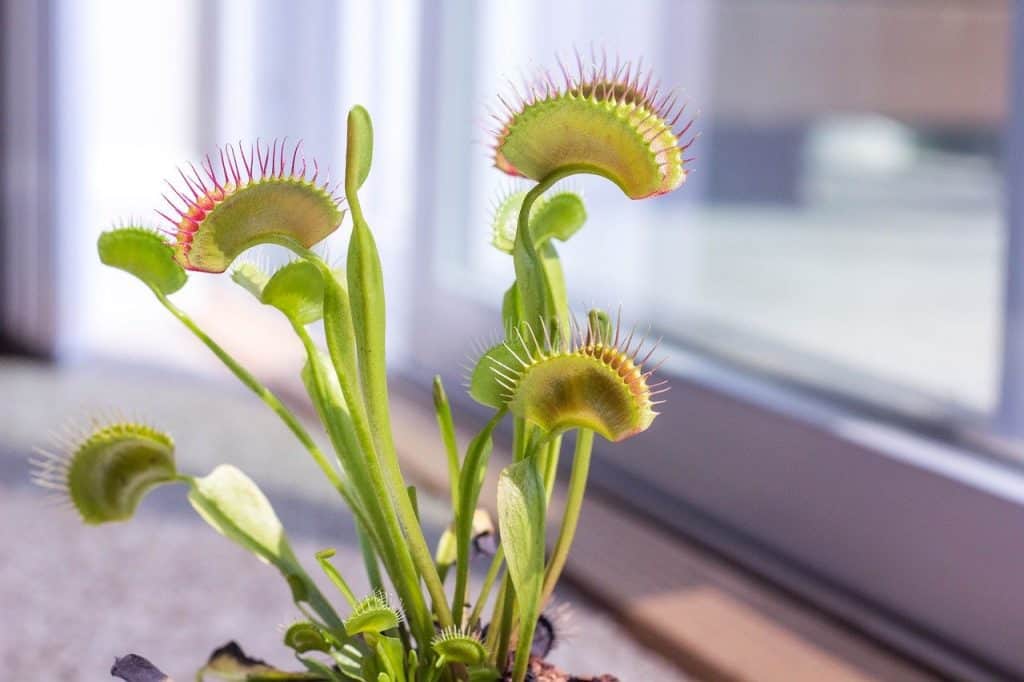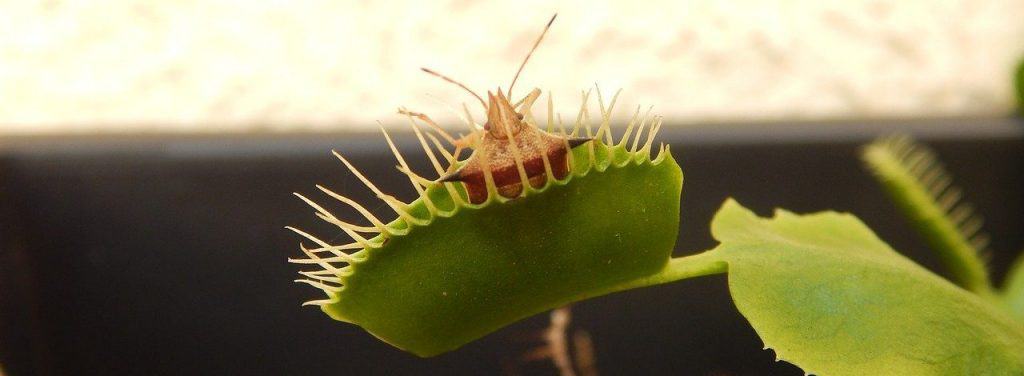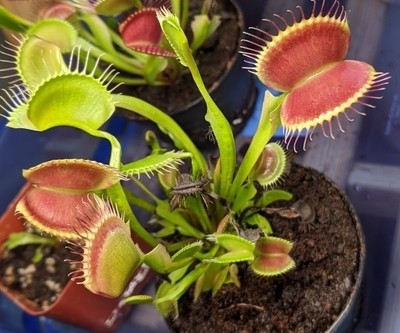Owning a Venus flytrap is an enjoyable experience, especially if it is your first time. The scientific name of a Venus flytrap is Dionaea Muscipula. But, you might want to give your plant a creative, funny, or cute name. In this short article, I will share with you some great name options for your Venus flytrap.
I like to name my plants not only because I like them, but due to practicality. All Venus flytraps are the same species, and at no surprise, the plants look very similar one from the other. It is hard to differentiate them and remember when it is time to repot, feed, or propagate them, for example. In my home, each plant has a name that I make sure to write down in the pot or a pot marker with some dates that indicate important information.
Explore the list of names below. I hope you can find the perfect name for your plant. Some names are more feminine; others are more masculine. But since Venus flytraps do not have a specific gender, any should work.
Venus Flytrap Name Ideas
- Hannibal
- Piranha Plant
- Vegetarian
- Snap Trap
- Toothy
- Carnivine (for the Pokémon fans)
- Carnivore
- Baby Shark
- Predator
- Alien (some people believe carnivorous plants look like out of this world)
- Hungry
- Greeny
- Shrek (Venus flytraps and Shrek are both green and they can eat)
- Snap/Snaps
- Little Plant
- Little Green
- Blushy (the red coloring is just beautiful)
- Colorado (another reference to the red color)
- Risky Business
- Trippy
- Bug Catcher
- Venus
- Sharp
- Scout
- Flower
- Tricksy
- Comet
- Bug controller
- Swampy
- Al or Ali
- Dino
- Damian
- Gator or Gator Plant
- Oli
- Carolina or Carolinas (We should not forget about its origin)
- Southern Beauty
- Sunny
- Lilly
- Gal
- Guy
- Spike
- Pet Flytrap
- Verdant
- Leafy
- Robin
- Green Doe
- Smiley
- Grinch
- Rouge
- Green goblin
I hope you found a name of your liking on the list or maybe just inspiration. Owning a Venus flytrap is many people’s childhoods dream and choosing a name for your plant is fun, but it is just the beginning. Now, you must learn how to take care of your plant.
As a parent, you can consider naming your Venus flytrap, especially if kids are involved in caring for the plant. Small children tend to get more attached and exhibit a greater interest when they connect with an activity. A simple name for a Venus flytrap can encourage children to learn more about the science behind these unusual plants and potentially work on some projects such as feeding the plant, building a terrarium, pollinating flowers, etc.
Carnivorous Plant Name Ideas
Here are some bonus options for Venus Fly Traps and other carnivorous plants:
- Truly killer
- Carnivora
- Savage leaf
- Danger bloom
- Flora fright
- Medusa
- Bug killer
- Dew
- Danger stalk
- Carniplant
- Menace
- Venom bloom
- Exterminator
- Gobble
- Leaf fang
- Vortex
Venus Flytrap Care for Beginners
Commonly, Venus flytraps are sold without proper care instructions. Novice Venus flytrap owners struggle to keep their plants alive due to a lack of knowledge and guidance. The section below is a summary of the most crucial care instructions for Venus flytraps. Make sure to review the list entirely and implement it. Then, your plant will be healthy. Also, you can download a Venus flytrap care sheet by visiting this article. The care sheet is a printable PDF document.
- Light: Venus flytraps need exposure to plenty of light. Optimally they should receive 12 hours of sunlight, and the minimum is 6 hours of light. The light source might be natural light or artificial lighting (here is an example of a good plant light)
- Water type: Venus flytraps must be watered with pure water only, such as rainwater, distilled water, and reverse osmosis water. Tap water and bottled water kill carnivorous plants. You can also use filtered water, but only when removing all minerals with ZeroWater filter.
- Watering frequency: the soil of the plant must always remain moist. Always keep the ground humid, but do not flood. Venus flytraps do not grow in swamps.
- Soil: Employ nutrient-free soil like this for carnivorous plants. Never employ enriched soil, full of fertilizers. This article covers many soil options for Venus flytraps.
- Feeding: Venus flytraps do not need to capture insects to survive, but they benefit from them greatly. Place Venus flytraps outdoors, and they will have plenty of access to food. Also, consider feeding your plant to provide extra nutrients.
- Suitable pots: Do not place Venus flytraps in enclosed containers. Venus flytraps prefer standard plant pots with drainage holes (here is a good example). The best pot materials for carnivorous plants are glazed ceramic pots and plastic. Depending on the plant’s size, choose a container that is about 2-6 inches in diameter. Also, preferably employ a tall container. Venus flytraps have long roots.
- Repotting: repot the plat once a year to avoid soil compression, fungus, and mold(this is how you can get rid mold).
- Trimming: When leaves in a Venus flytrap dry up, they turn black. Black leaves are normal as the plant is continually producing new leaves. Still, you can use a pair of scissors and remove the dead foliage. It is not necessary but beneficial.
- Fertilizers: Do not fertilize Venus flytraps. The chemicals in the fertilizers can hurt the plant.
- Temperature: Keep Venus flytraps in temperatures within this range: 32 F – 95 F (0 C – 35 C). Do not burn them in the summer and do not let them freeze in the winter,
- Humidity: Venus flytraps prefer humid climates but can adapt to dry environments. If you live in an arid environment, consider employing a humidifier.
- Terrariums: It is possible to grow Venus flytraps in a terrarium. Still, it is very challenging due to the lack of drainage and restrictions with lighting. As a new Venus flytrap owner, avoid terrariums.
- Flowers: After reaching maturity, Venus flytraps start producing flowers every spring. In the first year, you own a Venus flytrap, skip the flowering process. Cut off the flower stalks when they appear and prevent the flowers from developing. The flowering process causes strain to the plant. Skipping it allows for further growth and development.
- Stress: Do not play with the traps of your plant. Activating those traps for just fun cost the plant a lot of energy. Venus flytraps lose leaves when they undergo stress.
- Dormancy: In their natural habitat, Venus flytraps undergo a dormancy period for 2-3 months during the winter. Venus flytraps must go dormant every winter to remain healthy and live for many years. Ensure your plant will experience this resting period by placing them in a cold location. For example, outdoors, in a cold garage, or porch. Venus flytraps go dormant after been exposed to temperatures below 45 F (7 C) for several weeks. They exit dormancy as the climate warms up 2-3 months later.
Are you thinking about growing your Venus flytraps indoors? This guide: Venus Flytrap Indoor Care explains the requirements for lighting, watering, dormancy, and much more…

Fun Projects With Your Venus Flytrap
- Feeding: Feeding a Venus flytrap is a unique experience. As a Venus flytrap owner, I encourage fellow carnivorous plants enthusiast to feed their plants. Outdoors plants do not need to be fed, but feeding them won’t harm them. Indoor plants can survive without the bugs, but they will benefit from the extra nutrients. This article can teach you the step by step process of how to feed your plant. Have fun!
- Fun pots: Just by browsing around Etsy or other online stores, you can find some unique pots for your plant. When repotting, consider buying a unique plant pot. Are you ready to own a piranha plant? This plant pot I found online is perfect for a Venus fly trap. It resembles the green pipes from Mario games!
- Propagation: Are you ready to have multiple plants? You can propagate your plant through many different methods, such as stalk cuttings, seeds, and bulb divisions. This article contains the instructions and methods to propagate your plant: How Do Venus Flytrap Reproduce? – 4 Propagation Methods.
- Terrariums: Building a terrarium for Venus flytrap is not a beginner project. Venus flytraps thrive outdoors when they can have plenty of access to light and water. Still, some types of terrariums are optimal for carnivorous plants. For example, Green House type terrariums are great candidates. These terrariums are not sealed; they can be easily open and closed. Each plant inside the container remains in its pot. The plants do not require constant watering as most water remains in the terrarium, and the environment is humid.

Recommended Products for Growing Carnivorous Plants
Finding the best pots, lights, and soil for carnivorous plants is difficult. I have grown carnivorous plants for over 5 years, and these are the products I use. The links will take you to Amazon to view the prices and full specs:
- Carnivorous Plant Soil
- Carnivorous plant soil: https://amzn.to/422yLZa
- Artificial Lighting
- Small plant light for 1-2 plants: https://amzn.to/3oQsmSj
- T8 LED light fixture for multiple plants (6500k Cool White): https://amzn.to/3uWoeh2
- Pots and Miscellaneus
- Nursery pots for single plants: https://amzn.to/3oL8YGq
- TDS meter to measure water quality: https://amzn.to/3g8VKLI
- Dried crickets to feed carnivorous plants: https://amzn.to/34QEnKv


